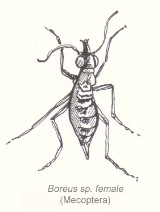
Snow scorpionfly
Encyclopedia
Boreidae, commonly called Snow scorpionflies, are a very small family of Scorpionflies, containing only around 30 species, all of which are boreal
or high-altitude species in the Northern Hemisphere
. Recent research indicates that the boreids are more closely related to flea
s than to other scorpionflies, which renders the order Mecoptera
paraphyletic if the order Siphonaptera is excluded from it.
These insects are small (typically 6 mm or less), with the wings reduced to bristles or absent, and they are somewhat compressed, so there is in fact some resemblance to fleas. They are most commonly active during the winter months, towards the transition into spring, and the larvae typically feed on mosses. The adults will often disperse between breeding areas by walking across the open snow, thus the common name. The males use their bristle-like wings to help grasp the female while mating.
A snow scorpionfly is so adapted to its cold environment just holding it in a human hand will kill it.
Boreal ecosystem
The term boreal is usually applied to ecosystems localized in subarctic and subantarctic zones, although Austral is also used for the latter....
or high-altitude species in the Northern Hemisphere
Northern Hemisphere
The Northern Hemisphere is the half of a planet that is north of its equator—the word hemisphere literally means “half sphere”. It is also that half of the celestial sphere north of the celestial equator...
. Recent research indicates that the boreids are more closely related to flea
Flea
Flea is the common name for insects of the order Siphonaptera which are wingless insects with mouthparts adapted for piercing skin and sucking blood...
s than to other scorpionflies, which renders the order Mecoptera
Mecoptera
Mecoptera are an order of insects with about 550 species in nine families worldwide. Mecoptera are sometimes called scorpionflies after their largest family, Panorpidae, in which the males have enlarged genitals that look similar to the stinger of a scorpion...
paraphyletic if the order Siphonaptera is excluded from it.
These insects are small (typically 6 mm or less), with the wings reduced to bristles or absent, and they are somewhat compressed, so there is in fact some resemblance to fleas. They are most commonly active during the winter months, towards the transition into spring, and the larvae typically feed on mosses. The adults will often disperse between breeding areas by walking across the open snow, thus the common name. The males use their bristle-like wings to help grasp the female while mating.
A snow scorpionfly is so adapted to its cold environment just holding it in a human hand will kill it.
Genera
This list is adapted from the World Checklist of extant Mecoptera species , and is complete as of 1997. The number of species in each genus is indicated in parentheses.- Boreus (24) Latreille, 1816 (North America, Europe, Asia)
- Caurinus (1) Russell, 1979 (Oregon)
- Hesperoboreus (2) Penny, 1977 (USA)
See also
- Snow flies genus Chionea - a convergentConvergent evolutionConvergent evolution describes the acquisition of the same biological trait in unrelated lineages.The wing is a classic example of convergent evolution in action. Although their last common ancestor did not have wings, both birds and bats do, and are capable of powered flight. The wings are...
genus of wingless crane fliesCrane flyA crane fly is an insect in the family Tipulidae. Adults are very slender, long-legged flies that may vary in length from though tropical species may exceed to .... - ApteropanorpidaeApteropanorpidaeApteropanorpidae is a family of wingless scorpionflies containing a single genus Apteropanorpa with four named species. These species, also called Tasmanian snow scorpionflies are found in moss in Tasmania and southern Australia. The adults are generalised predators...
- another family of wingless scorpionflies

